Greenhouse Gas Emissions (CO2-CH4) From Municipal Solid Waste Management Using Life Cycle Assessment (LCA) in Mahdsht City (IRAN)
M Naderi1 * , M. Salari Baghonabad1 , M. J. Amiri2 and M. Rezazadeh3
1
Management and Training of Environment,
Environment Faculty,
University of Tehran,
Iran
2
Department of Planning,
Management and Training of Environment,
Environment Faculty, University of Tehran,
Iran
3
Department of Environment,
University of Tehran,
Iran
DOI: http://dx.doi.org/10.12944/CWE.9.2.31
Copy the following to cite this article:
Naderi M, Abad M S. B. , Amiri M, Rezazadeh M. Greenhouse Gas Emissions (CO2-CH4) From Municipal Solid Waste Management Using Life Cycle Assessment (LCA) in Mahdsht City (IRAN). Curr World Environ 2014;9 (2) DOI:http://dx.doi.org/10.12944/CWE.9.2.31
Copy the following to cite this URL:
Naderi M, Abad M S. B. , Amiri M, Rezazadeh M. Greenhouse Gas Emissions (CO2-CH4) From Municipal Solid Waste Management Using Life Cycle Assessment (LCA) in Mahdsht City (IRAN). Curr World Environ 2014;9(2). Available from: http://www.cwejournal.org/?p=66
Download article (pdf) Citation Manager Publish History
Select type of program for download
| Endnote EndNote format (Mac & Win) | |
| Reference Manager Ris format (Win only) | |
| Procite Ris format (Win only) | |
| Medlars Format | |
| RefWorks Format RefWorks format (Mac & Win) | |
| BibTex Format BibTex format (Mac & Win) |
Article Publishing History
| Received: | 2014-06-17 |
|---|---|
| Accepted: | 2014-07-29 |
By the urbanism expansion and population increases, one of the most important topics is the optimum management of produced residue. Today, in addition to the rapid growth of urbanism, increasing in income level and welfare of the society and rapid economic and social growth in countries, which cause quantity changes in waste production, changes in consumption patterns has led to quality changes. Integrated solid waste management (ISWM) is a term that is used for all of the activities that related with waste management of a society; the main aim of integrated solid waste management is to organize the society waste in a manner that supplies general health and environmental aspects and people’s demands for reuse of wastes and recycling. A life cycle assessment (LCA) is a technique to assess environmental impacts associated with all stages of a product’s life from-cradle-to-grave (i.e. from raw material extraction through materials processing manufacture, distribution, use, repair and maintenance and disposal or recycling) LCA’s can help avoid a narrow outlook on environmental concerns by
- Compiling an inventory of relevant energy and material inputs and environmental releases
- Evaluating the potential impacts associated with identified inputs and releases
- Interpreting the results to help you make a more informed decision
There are four linked components of LCA
Goal definition and scoping:
Identifying the LCA's purpose and the expected products of the study, and determining the boundaries (what is and is not included in the study) and assumptions based upon the goal definition;
Life-cycle inventory
Quantifying the energy and raw material inputs and environmental releases associated with each stage of production;
Impact analysis
Assessing the impacts on human health and the environment associated with energy and raw material inputs and environmental releases quantified by the inventory;
Improvement analysis
Evaluating opportunities to reduce energy, material inputs, or environmental impacts at each stage of the product life-cycle. The goal of LCA is to compare the foul range of environmental effects an assignable to products and services (such as waste management) in order to improve processes, support policy and provide a sound basis for informed decisions (US EPA, 2010). The choice of selected indicators for LCA can provide options for the improvement of the existing systems. Such a damage assessment based on the existing life cycle of natural gas combustion district heating system at a rural location in British Columbia was conducted by Pa et al(2006,2012) recently. Similar region-specific LCA studies for woodchip-based ‘green electricity generation’ in Austria (Siegl, S and et al,2012). Municipal solid waste (MSW) generally includes degradable (paper, textiles, food waste, straw and yard waste),partially degradable(wood, disposal napkins and sludge) and non-degradable materials (leather, plastics, rubbers, metals, glass, ash from fuel burning like coal, briquettes or woods ,dust and electronic waste).Generally MSW is managed as collection from streets and disposal at landfills (ArvindK.Jha and et al,2007). Life cycle assessment (LCA) is a process of evaluating environmental burdens or benefits associated with the total life cycle of a product. This is conducted by identifying and quantifying the energy and materials used and waste products released into the environment (Siegl, S and et al,2012). The significance of LCA lies in the fact that it equips the policy makers and decision makers for adoption of suitable and sustainable energy supply systems. Increasing global concern due to air pollution and to limited oil reserves has generated much interest in environmental friendly alternatives to petroleum-based fuels (Merola, SS and et al,2012). LCA (Life Cycle Assessment) has been used as an effective environmental management tool in much different kind of studies. For example, A number of studies in the literature used LCA as a comparative tool for different MSWM schemes (Su et al., 2007; Ahluwalia and Nema, 2007; Liamsanguan and Gheewala,2008; Villeneuve et al., 2009; Manfredi and Christensen, 2009; Banar et al., 2009).Some of the models conduct the Life Cycle Analysis (LCA) of the waste disposal system while other only focus on different environmental elements such as noise or traffic (Chang et al, 1996) or on CO2 emissions from vehicles (Wang at all, 1988).A group of computer models apply the concept of Life Cycle Analysis (LCA). The example of such models are: the US-EPA (Barlazet al, 1995), Integrated Waste Model IWM (White et al, 1997), MIMES/Waste (Sundberg, 1995), ORWARE (Eriksson et al, 2002). An LCA study on alternatives for residual municipal solid waste management presented Umberto Arena Susan Thorneloe presented a paper on the US EPA landfill life cycle inventory. also we have several studies in different cases such as in order to lower the VOC content of paint in the paint industry (Dobson ,1996), to reduce the environmental burdens of the used automotive batteries (Robertson et al.,1997), to compare different forestry operations of clear cutting and shelter wood cutting in forest management systems (Berg,1997), to compare three degreasing processes in the metal-processing industry and to optimize each process, both environmentally and economically (Finkbeiner et al.,1997), to assess different scenarios of treatment of municipal wastewater (Roeleveld et al.,1997), etc.
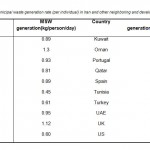 |
Table 1: Municipal waste generation rate (per individual) in Iran and other neighboring and developed countries Click here to View table |
Materials and Methods
Mahdasht city with a population of about 55’000 and a square of 6116/1 hectare is situated in the south-west of Karaj city (capital of Alborz province) with a distance of 18km from Karaj. This city with agricultural lands with a square of 2700 hectare is one of agricultural centers of Alborz province. The amount of waste production of this city is about 8400 ton per year (74.1% of wastes are wet and 25.9% solid).
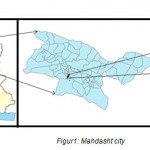 |
Figure 1: Mahdasht city |
In this paper production of greenhouse gases (CO2-CH4) in different waste management options in Mahdasht city by using Life Cycle Assessment (LCA) method had been studied using IWM3 software. Two scenarios of integrated waste management in the Mahdasht city were compared using the LCA methodology. The scenarios were described using data extrapolation on the basis of data collection referring to 2013. In scenario1 considered that all of the wastes sent to the landfill (100% equivalent with 8395ton) and in scenario2 considered that 20% of produced wastes (equivalent with 1679 ton) transform to compost and 4% of produced wastes (equivalent with 336 ton) are recycled and remained as produced wastes (76% equivalent with 6380 ton) sent to a landfill.
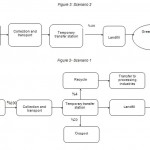 |
Figure 2: Scenario 1 and Figure 3: Scenario 2 |
Results
The broad perspective offered by LCA makes it a powerful tool for environmental comparison of different options for waste management in Mahdasht city in 2011, considering the intricate complexities of material and energy flows. By means of this technique results has been shown in the tables below.
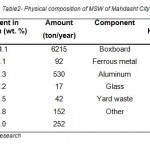 |
Table 2: Physical composition of MSW of Mahdasht City Click here to View table |
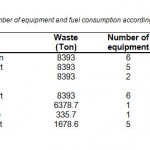 |
Table 3: Number of equipment and fuel consumption according to scenarios. Click here to View table |
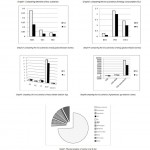 |
Graph 1 - 8 Click here to View Figure |
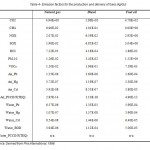 |
Table 4: Emission factors for the production and delivery of fuels (kg/GJ) Click here to View table |
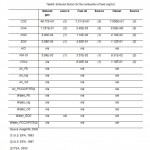 |
Table 5: Emission factors for the combustion of fuels (kg/GJ) Click here to View table |
Conclusion
The present study estimates production of greenhouse gas emissions (CO2-CH4) in the waste management system in Mahdasht city in IRAN. Two scenarios are assessed: scenario 1 direct and complete transfer of waste to the landfill and scenario 2 transferring 76% of the waste to the landfill (20% recycled, compostable and 4%). The life cycle inventory cataloging was done using the IWM-1model environmental point of view, the results of this study showed that composting and recycling operations have an important role in reducing the burden of pollutants and energy consumption of a waste management system. In this study, the data entered into the software (IWM), and the results provided by the software approach to Life Cycle Assessment (LCA) had been studied and were compared with each other. Given the amount of greenhouse gases in the second scenario (combination of recycling, composting and landfill) produce about 6,801 tons compared to the first scenario (only landfill) which produced about 9218 tons, the results indicates a significant reduction in the amount of harmful gasses. It is concluded that if the combined method (scenario 2) is used, it can lead to reduction in greenhouse gas emissions by as much as 26 percent.
References
- Ahluwalia, P.K.. and Nema, A.K.. ‘A life cycle based multi-objective optimization model for the management of computer waste’. Resources, Conservation and Recycling, 51, pp. 792-826. (2007).
- ArvindK.Jha,C.Sharma, Nahar Singh, R.Ramesh, R.Purvaja, Prabhat K.Gupta. Greenhouse gas emissions from municipal solid waste management in Indian mega-cities: A case study of Chennai landfill. (2007). sites,www.elsevier.com\locate\chemosphere.
- Banar, M., Cokaygil, Z., Ozkan, A.’Life cycle assessment of solid waste management options for Eskisehir, Turkey’. Waste Management, 29, pp. 54-62. (2009).
- Barlaz, M.A., Ranjithan, R., Weitz, K.A. and Nishtala, S.R. Life-Cycle Study of Municipal Solid Waste Management, System Description. US Environmental Protection Agency, USA. (1995).
- Berg S. Some aspects of LCA in the analysis of forestry operations. j clean Prod;5:211-7. (1997).
- Chang, N.B., Shoemaker, C.A. and Schuler, R.E. Solid Waste Management System Analysis with Air Pollution and Leachate Impact Limitations. Waste Management and Research 14, pp.463-481. (1996).
- Dobson ID.Life cycle assessment for painting processes: putting the VOC issue in perspective. Prog Org Coat;27:55-8.(1996).
- Eriksson, O., Frostell, B., Bjorklund, A., Assefa, G., Sundqvist, J.O., Granath, J., Carlsson, M., Baky, A., Thyselius, L. ORWARE-a simulation tool for waste management. Resources, Conservation and Recycling 36, pp. 287-307. (2002).
- Finkbeiner M., Haffmann E. and kreisel G. (1997)Environmental auditing: the functional unit in the life cycle inventory analysis of degreasing processes in the metal processing industry. Environ Manage:21:635-42.
- Gunilla,J. LCA — A Tool for Measuring Environmental Performance: PIRA International, 190p.
- Haight.M.(2004). Technical Report: Integrated Solid Waste Management Model, School of Planning University of waterloo, March9. (1996).
- "Life Cycle Assessment (LCA). US Environmental Protection Agency. 6 Aug. (2010). Web.
- Liamsanguan, C. and Gheewala, S.H. LCA: A decision support tool for environmental assessment of MSW management systems. Journal of Environmental Management, 87, pp.132-138. (2008).
- Manfredi, S. and Christensen, T.H. Environmental assessment of solid waste landfilling technologies by means of LCA-modeling. Waste Management, 29, pp. 32-43. (2009).
- Merola, SS, Tornatore, C, Marchitto, L, Valenteno, G. and Corcoine, FE. Experimental investigations of butanol-gasoline blends effects on the combustion process in a SI engine. Int. J. Energy Environ. Eng 3, 6. (2012).
- Pa, A, Bi, XT. And Sokhansanj, S. A life cycle evaluation wood pellet gasification for district heating in British Columbia. Biores. Tech 102, 6167–6177 . (2006).
- Pa, A, Jill, C, Bi, XT, Staffan, M. and Sokhansanj, S. Environmental footprints of British Columbia wood pellets from a simplified life cycle analysis. Int. J. of Life Cycle Asses 17, 220–231 . (2012).
- Robertson JGS, Wood JR, Ralph B. and Fenn R. Analysis of lead\acid battery life cycle factors: their impact on society and the lead industry. J Power Sources;67:225-36. (1997).
- Roeleveld PJ , Klapwijk A. Eggels PG, Rulkens WH, Starkenburg W. Sustainability W.S. USTAINABILITY OF MUNICIPAL WASTEWATER TREATMENT. Water Sci Technol1997:35:2218. Page CA, Diamond ML, Campbell M. McKenna S. Life-cycle framework for assessment of site remediation options: case study. Environ toxicol and chem., vol , 18. USA'SETAC..p.801-10. (1996).
- Villeneuve, J.; Michel, P.; Fournet, D.; Lafon, C.; Ménard, Y.; Wavrer, P.and Guyonnet, D. ‘Process-based analysis of waste management systems: A case study’. Waste Management, 29,pp. 2-11.( 2009).
- Siegl, S, Laaber, M. and Holubar, P. Green electricity from biomass, Part 1: environmental impacts of direct life cycle emissions. Waste Biomass Val 2, 267–284 . (2011).
- Su, J., Chiueh, P., Hung, M. and Ma, H. Analyzing policy impact potential for municipal solid waste management decision-making: A case study of Taiwan. Resources, Conservation and Recycling, 51, pp. 418-434. (2007).
- Sundberg, J. Municipal solid waste management with the MIMES/waste model. A complementary approach to LCA studies for evaluating waste management options. Workshop on LCA and treatment of solid waste. Stockholm, Sweden, 28-29 Sept. 1995, pp. 252-258. (1995).
- Wang, F.S., Richardson, A.J. and Roddick, F.A. SWIM – A Computer Model for Solid Waste Integrated Management. Computers, Environment and Urban Systems 20(4/5), pp. 233-246. (1988).
- White, P.R., Franke, M. and Hindle, P. Integrated Solid Waste Management - a Life cycle Inventory. Blackie Academic & Professional. (1997).







